Interested in dredging for gold? This is my page of information on placer mining for gold with a suction dredge......
| Diving for gold in the streams of California has been a popular activity for many years. Diving was first done in California by the 49ers during the days of the gold rush. Their equipment did not allow them to conduct continued operations, but the old timers knew there was gold in the bottoms of the streams - a place they couldn't easily reach. Bucket line dredges which used long chains of large steel buckets to dig gravel from stream beds were first operated successfully in the 1890s, but still these were large affairs operated by mining companies. It wasn't until the 1950s, with the advent of lightweight portable “lawn mower” type engines, that portable suction dredges became small enough that they could be transported and run by a single operator. At that same time scuba diving equipment also became easily available. During these early days, there were no manufacturers that sold suction gold dredges, they were handmade in garages and small shops by men like Ernie Keene. Today, a number of makers produce a variety of gold dredges in all sizes, including the family of Ernie Keene. | ||
A suction dredge is basically a device which is designed to suck gravel from the bottom of a river, pull it up through a hose and run it over a sluice box. In the sluice box, any gold which is present becomes trapped and the lighter materials such as sand and gravel move down and out of the sluice box and back into the river. The operator guides to the nozzle of the hose to suck the rocks and gravel which he desires to process off the river bottom. A small “lawn mower” type engine is used to pump water which creates the suction that pulls the sand and gravel up through a hose and into the sluice box. The suction in the hose is actually created through a Venturi effect by pumping high pressure water through a jet. The fast-moving water creates the suction in the jet. This way the sand and gravel does not actually go through the pump which would quickly wear it down. There are two main types of jets currently being used. These are 1) The suction nozzle where the jet is up at the nozzle point, and 2) The power jet where the jet is located up near the sluice box. In addition to pumping water, the small engine also produces compressed air for the diver to use while underwater. In cases where the water is shallow the gold diver may simply use a snorkel. Most modern dredges are made to float on the surface of the water, allowing the operator the greatest level of flexibility to move from place to place and work small deposits. Most flotation systems are made of rigid plastic pontoons, but there are still a number of units in use which employ other flotation systems such as truck inner tubes. | 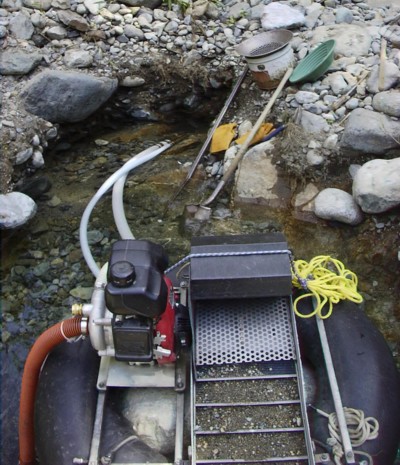 | |
Today's suction dredges have come a long way from those early days – they are far more efficient, lightweight and reliable than their early predecessors. They come in a wide variety of designs and sizes of intake. Suction dredges are commonly available “off-the-shelf” in sizes ranging from an intake of 2 inches up to an intake of 10 inches. The larger the intake size, the more material will be processed through the dredge each hour of operation. However, the larger the intake, the heavier the dredge will be, and with increased weight there is decreased portability. In addition, dredges with intake sizes larger than 5 inches can be difficult for a single operator to manage. Quite a bit of improvement has also been made in the capture efficiency of the dredge sluice boxes, and many designs support undercurrent sluice systems to increase fine gold recovery. The lightweight, portable suction dredge allows the individual prospector the ability to explore a world of gold deposits that the old timers had great difficulty reaching. The old timers could build dams and divert the rivers in some locations, but today's prospector simply dons his wetsuit fires up the motor on his dredge and dives under water. The modern dredge can be easily moved around and take it to new locations as necessary to prospect new areas. | ||
The first step in underwater prospecting is a careful examination of the stream itself and the adjacent terrain. Natural features that should be noted are topography the nature of the bedrock including any joint and crevices systems, stream currents, bends in the streams and other visible underwater features such as large boulders or any other type of barriers that might act as a trap for gold. A where the natural features cause some change in the volume of water flow which results in a sudden decrease in stream velocity, those are the conditions favorable for gold deposition. The inside portions of river bends and the downstream area behind boulders and rock outcrops are common places to search for gold deposits. Deep narrow crevices and cracks especially those that occur in steeply dipping rocks whose strike or trend is perpendicular to the stream flow are particularly favorable for the occurrence of gold. A series of parallel the deep narrow cracks or crevices at right angles to the direction of the stream are especially good because they form natural riffles. Such traps are most likely to be found in slate, schist, gneiss and other heavily jointed rocks. The gold is almost always concentrated at or near the very bottom of such natural traps it may occur as flat or rounded grains and flakes ranging from microscopic sized nuggets up to several inches long coarser gold is usually found at the greatest depths. The underwater dredger, armed with the right equipment, has a special opportunity to work these cracks and crevices and discover the gold they contain. | 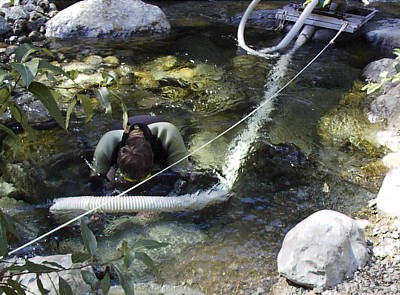 | |
The particles of gold found in the streams originally came from veins, mineralized zones, and older placer deposits from which they were released by weathering and disintegration of the rock. The efficient prospector will evaluate locations being considered for dredging and test them by sampling before bringing in his dredge. Even once the dredge is brought in, the dredger will sample around in the River to find good gold bearing deposits and pay streaks that can be worked profitably with a dredge. In many cases, the first step in dredging is to remove the layer of overburden gravels which often cover the bedrock. When removing overburden it is best to plan ahead and start downstream and move upstream so as not to force yourself to re-dredge your own tailings. Any deep and narrow crevices which are found under the overburden must be completely cleaned out to the deepest level because it is here where most of the gold is to be found. A rugged crevicing tool may be most helpful in accomplishing this project. For those prospectors interested in building their own suction gold dredge, I did up a web page on Build Your Own Suction Dredge Plans | 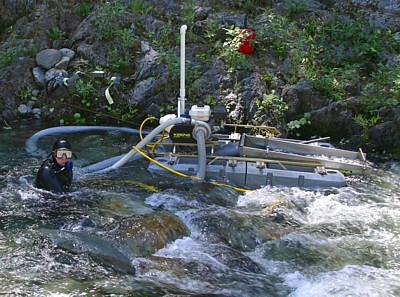 | |
| Small scale suction dredging is an exciting and interesting pastime. Even though it's very unlikely that you will strike it rich or make a big gold find, a good amount of gold is found by those who know what they're doing and where to look. Many folks spend considerable amount of time dredging each year. Summer and fall are usually the best times of the year to dredge for gold because the water in the streams is low and clear. However, there are some areas that are best worked at other times of the year, and on some streams in which the water is only seasonal, one has to work during the time when the water is present. Under those conditions, the dredger may be forced to work in murky water. Clear water allows the operator to see both the gold in the river as well as any hazards and may be present. There are also legal limitations and permits that limit the times of the year in which dredging may be conducted on some streams. Different states have different laws, so it is important to find out which rules apply in your location. | 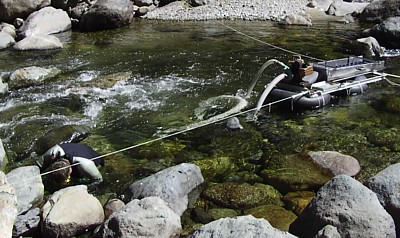 | |
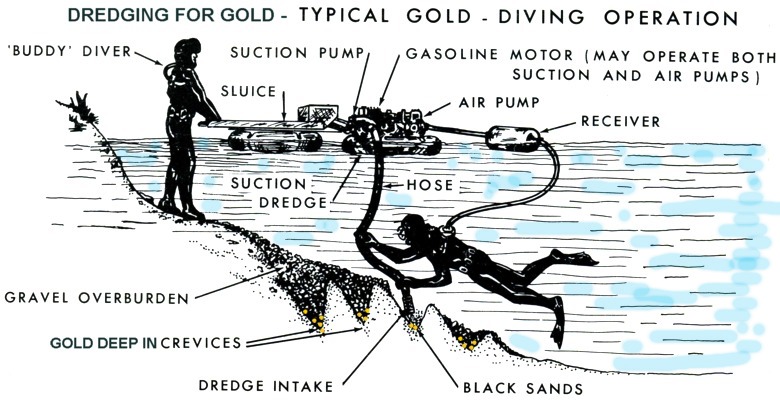 | ||
Comments: 0
Post a Comment